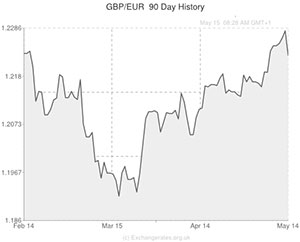
The Pound to Euro exchange rate (GBP/EUR) is currently trading close to the yearly high of 1.2257 that the currency pair achieved on February 17th.
Sterling was supported by some strong manufacturing data on Friday, which showed that output improved by 0.5% during March. The robust report signalled that factory activity expanded at its fastest rate since 2010 during the first quarter.
It was also reported that the British trade deficit of goods and services closed from £1.7 billion to £1.3 billion during March. The improvement in the UK trade balance reflected a slight rise in exports as demand rose for finished manufactured products such as jewellery and cars.
Friday’s sturdy manufacturing data and mildly pleasing trade figures built upon the optimism generated earlier in the week when it was announced that the UK service sector – which accounts for over 75% of British economic output – grew at its fastest level for five months during April. The optimistic 58.7 services PMI print has subsequently had a massively pos0itive impact on demand for Sterling.
On the other side of the coin we have the Euro, which flagged against most of the majors last week due to European Central Bank President Mario Draghi’s latest bout of dovish rhetoric. The ECB Chief gave a number of strong hints during his press conference on Thursday that monetary policy will be loosened next month.
The most important data release for the GBP/EUR currency pair during the week is likely to be Wednesday’s UK unemployment report. The headline jobless figure is expected to fall from 6.9% to a fresh 5-year low 6.8%. And the economy is anticipated to have added a further 248,000 people to the payroll in the first quarter.
If the jobs data prints inline with the median market forecast then it is entirely possible that we could see the Pound to Euro exchange rate (GBP/EUR) settle above technical resistance at 1.2257.
Sterling is currently trading close to a 15-month high against the single currency because of the divergence in outlooks of the Bank of England and the European Central Bank. At the moment it is thought that the BoE will start hiking rates in the second quarter of 2015. However, the central bank could be persuaded to start normalising monetary policy sooner than that if British data continues to impress.
Sterling is likely to appreciate versus the Euro if investors begin to bring forward their rate hike projections

Comments are closed.